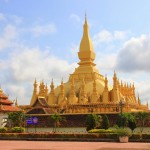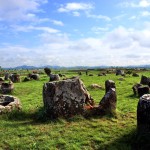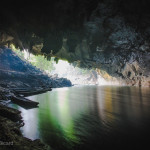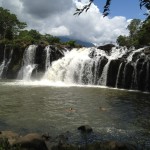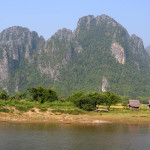Luang Prabang top city 2015
Lovely Luang Prabang scooped ‘Best City’ in the Wanderlust Travel Awards 2015 – not the first time it’s received the award! We reveal why it’s our readers’ perennial favourite – and discover the other gems that the region holds…
The procession made its way past the former Royal Palace and through the heart of Luang Prabang, a dazzling mix of marching bands, dancers, drummers, martial arts displays, ethnic groups, saffron-robed monks and Miss Lao New Year resplendent on a big wooden buffalo. Then, there it was, among all this, a ‘Wanderlust Travel Awards’ banner, bobbing proudly over the crowds.
It was Lao New Year 2012, and Luang Prabang was celebrating several achievements in its parade – including having been voted Top City in the world by Wanderlust readers for the sixth time. It’s unsurprising: wearing its heart and heritage on its sleeve, the city charms every visitor with its mix of traditional culture, French colonial architecture and embracing atmosphere. Each April, it also becomes the focus of the country’s New Year festivities.
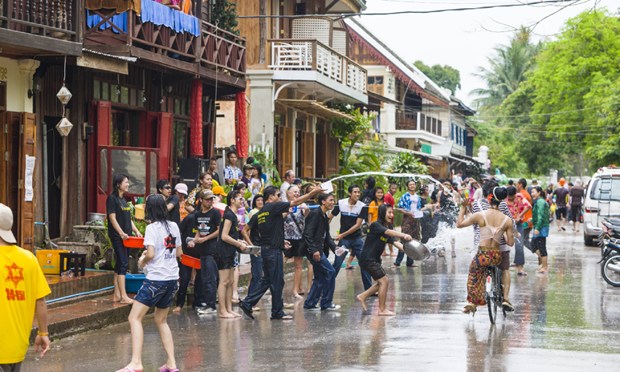
People throw water on each other as part of the New Year festival (Shutterstock)
The Miss Lao New Year beauty pageant was the talk of the town – indeed, the nation. Each of the contestants had a vociferous group of supporters in the crowd, chanting and waving placards with their favourite’s ‘number’ on it. As beauty pageants go, this was a classy affair, with the girls gliding around in traditional dress. Two glossy presenters were making the same sort of cheesy comments found at these events the world over. It was a surreal mix of X Factor final and elegant fashion show.
Finally, number 17 won; her prize, a motorbike plus 10 million yip (around £800). The crowd bellowed its support.
Land of the elephant
I was tired the next day – and not just because of the late night at the pageant (and having knocked back more than one glass of Beerlao: ‘beer of the wholehearted people’). I was due to have a cookery lesson at my hotel that morning, and so had risen early to accompany Somroj, the chef, to the market.
We strolled through quiet streets, where women squatted in front of mats topped with fresh produce. Some had just one or two different types of vegetable or herbs, others a whole range; some items were identifiable, others not. “The Lao people really know everything to eat, from the land and the water,” explained Somroj, who originally hails from Thailand.
A few sellers had buckets of frogs and toads; several had small rattan cages, birds flitting inside. “People are not buying them today for eating, but for setting them free for merit,” explained Somroj. “There’s not so much to buy as usual here today, I think because of the New Year,” he mused. However, we still came away with river weed and basil, shallots and aubergines.
After breakfast, I got chopping in the hotel’s purpose-built training kitchen. We made spring rolls filled with stir-fried vegetables followed by mok, banana leaves stuffed with minced fish in an aromatic lemongrass paste. As they steamed we moved on to a fiery soup and a coconut-milk curry. The exquisite food more than made up for the early start.
Eager to explore a little further afield, I headed to the Elephant Village. Laos was once known as the Land of a Million Elephants; today there are only 1,600 left.
The Elephant Village was set up in 2003 by a German called Markus Peschke. He wanted to ensure the preservation of a forested valley 12km from town, to give former logging elephants a better life, and to create something that would benefit local communities. So, he put the three together.
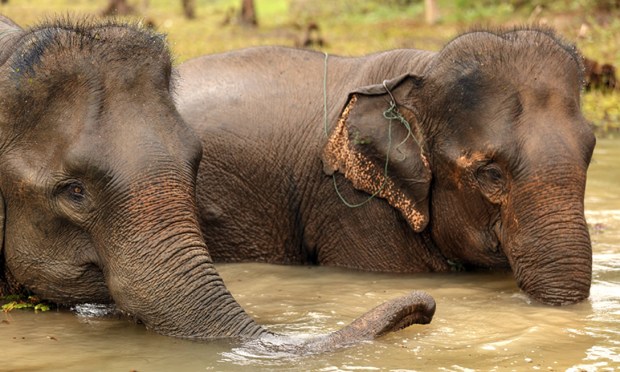
Asian elephant bathing in muddy water, Laos (Shutterstock)
There are currently nine elephants at the sanctuary, all bearing the scars of their days working in the logging industry. I rode Mae Khammung, a 32-year-old female with a cheerful mahout (elephant rider), Mr Mee. We crossed the river, turning away from the direction the other elephants were taking, and took a trail through teak forest. A deafening cicada soundtrack filled the air, and a monkey called nearby. After a gentle 90 minutes we reached the Tad Sae waterfall – a bit of a misnomer just before the rainy season as there’s scarcely a trickle of water.
Here I bade farewell to Mr Mee and Mae Khammung and headed down to the Huay Sae River. Here a luxury raft awaited to carry me downstream, back to the Elephant Village, and back to Luang Prabang – where the party was in full flow…
Flour power
The city streets were full of groups of people armed with water – both clear and coloured – ready to ambush any car or motorbike that ventured by. I escaped, taking a boat over the Mekong River and watching as other passengers overturned buckets of fish and released caged birds. A sandbar was the focus for further celebrations – families and friends had converged to build sand stupas (mound-like shrines) decorated with flags, incense sticks and anything else they deemed applicable. Meanwhile, young boys prowled with bags of flour, dumping the contents over anyone they could sneak up on.
Further along the island were shaded tables, food stalls, music and dance areas. As the afternoon went on, more and more people poured in and the music, mostly live, veered from traditional ballads to the latest pop hits. The most popular number of all had everyone line-dancing, the flour-spattered revellers looking like something from Michael Jackson’s Thriller video.
It was another early start the next morning, in order to find a good spot for the Sai Bat alms-giving ceremony at the Royal Palace – another attempt to gain merit in the Buddhist religion by making offerings (usually sticky rice) to the monks. I crouched on a mat, a carrier bag of sweets in front of me – it was all I had managed to buy from the stalls outside, but I’d been assured the monks would appreciate them. A kindly lady next to me had a silver urn of still-warm rice, so scooped some out and onto my bag.
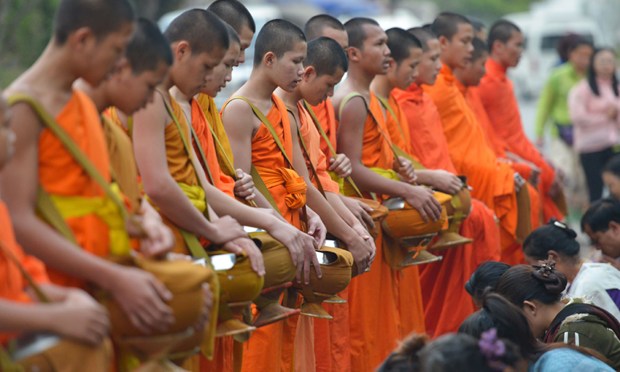
Monks collenting alms, Laos (Shutterstock)
The line of solemn orange-robed monks appeared, at least 200 long. I dished out my rice and sweets, generously at first, then more carefully as I realised how long the crocodile was, before being magnanimous again when the end of the line was near. It was then time for a traditional climb to the top of Mount Phousi, the sacred hill at the heart of the city. It is 328 steps to the top, where worshippers make offerings at a stupa. From here there were spectacular views sweeping down to the city, and over the Mekong.
Within an hour I was down on the Mekong myself, leaving Luang Prabang by motor launch. We headed upstream and pulled in at a limestone cliff, 25km from the city, to visit the Pak Ou Caves. An imposing peak marked the entrance to the Nam Ou River, the water two-tone where the latte-coloured Nam Ou meets the mocha-hued Mekong.
Our boat turned up the Nam Ou and for several hours we chugged through a timeless Laos of small farmers’ plots, stilt houses nestled among the trees, swimming children, wallowing water buffalo and hillsides scarred by the practice of slash-and-burn agriculture. In the rapids, wooden constructions were being used to trap fish and pan for gold. The river was shallow – sometimes we bumped along the bottom – but our boatman was one of the few who can successfully navigate the river at the end of the dry season.
The conflict on the quiet
By late afternoon we pulled up at the village of Nong Khiaw, set in a pretty spot flanked by mountains. This is a popular staging post for routes to or from Luang Prabang, and a good base for trekking, but I had other plans. The next day I headed a bit further upstream to Muang Ngoi, a village with no road access and only limited electricity.
We set out on a guided walk with a man called Sumlan, first stopping at Tam Kang, a limestone cave that was home to 384 locals for 12 years during the 1960s and early 70s. While we’ve all heard of the ‘Vietnam War’, it was actually neighbouring Laos that, during this period, gained the distinction of being the most bombed nation (per capita) in history. This ‘Secret War’ covertly pitted the USA and Royal Lao Government against the Pathet Lao – communists allied with North Vietnam.
Sumlan explained that his mother was born in the cave. The villagers would hide here during the day, only leaving after dark to tend their fields. The roof was still blackened with their cooking smoke.
Leaving a leafy pathway behind, we walked on through dry paddy fields, the day getting hotter and more oppressive by the minute. Low rumbles of thunder were echoing around the nearby mountains.
By lunchtime we had reached the welcome shade of the village of Ban Na, home to a mixed community of Lao and Khmu people. The wooden houses were mostly on stilts, pigs and hens rooting around beneath. In the middle of the day, few people were around. A friendly monkey ran up and jumped on me; its mother had been killed for food by hunters and it is now kept in the village, frustrating the dogs as it bounces out of their way. A couple of children sat absorbed in a book donated by Luang Prabang charity Big Brother Mouse.
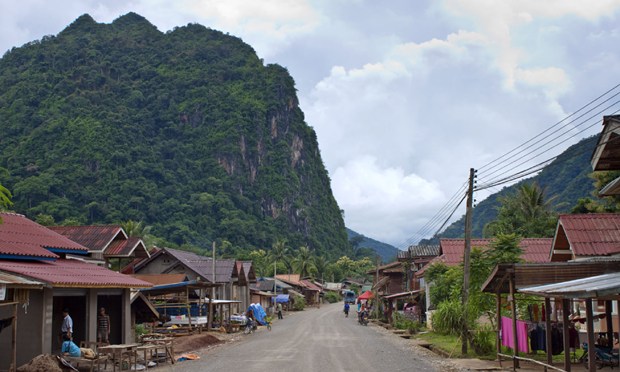
Nong Khiaw, Laos (Shutterstock)
We headed out of the village by a different route, the sky dark and menacing above us. There was still no rain but the thunder now boomed around the hills, while the sky continually flashed with lightning. Despite the beautiful surroundings, it was suddenly easy to imagine bomber planes appearing over the horizon.
Going underground
The next day we left early from Nong Khiaw by road, taking Route 1C, often described as one of the most beautiful highways through Laos. It snaked through traditional stilt villages, past hillsides smoking from slash and burn, and spectacular mountain scenery too. The road was near empty; in the four hours until our stop at the town of Vieng Thong, we passed only five cars.
By dusk we reached the provincial capital of Sam Neau. It is known for its ethnic groups, weaving and market, but I was anxious to press on. The next morning we covered the last 20km to Vieng Xai, home to the caves that were the headquarters of the Pathet Lao during the ‘Secret War’. The road led past beautiful karst outcrops into a large fertile valley. The land was dotted with duck ponds and little settlements, and surrounded by limestone cliffs pocked by hundreds of caves.
We stopped at a village that is home to more than 50 people who were handicapped during the war. At a building that serves as a Disability Centre, I was offered tea and told of the day in 1964 when, at 5pm, 12 villagers were killed by American planes. From then until 1972, around 175 tonnes of bombs a day were dropped in the valley.
A 60-year-old gentleman called Mr Pansy showed me his false leg. “I was simply a farmer here. We didn’t know who was bombing us or why. I don’t care about losing my leg,” he said. “But I do care about the family and friends I lost.”
We drove on to the attractive small town of Vieng Xai, built in 1973 after a ceasefire was declared. The lake at its heart was a large bomb crater, and today supplies fish to a couple of lakeside restaurants. I headed first for the Viengxay Caves Visitor Centre where you can arrange a guided tour of some of the caves that were used by the Pathet Lao. My guide, Bounmisai, passed me an audio headset with an entrancing commentary in English.
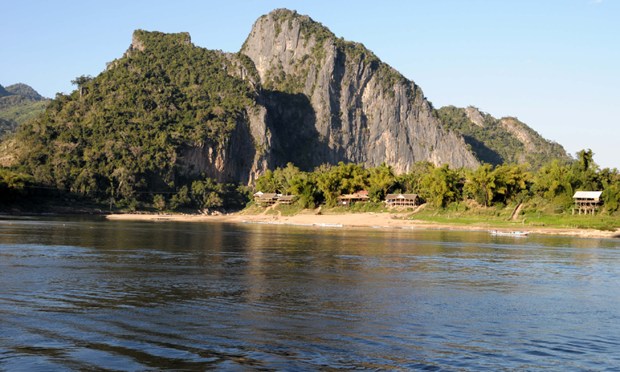
Mekong River, Laos (Shutterstock)
We first walked to Kaysone House, now a museum, but former residence of Pathet Lao leader (and eventual president) Kaysone Phomvihane after the bombing stopped. Behind it, steps led up to his previous abode, a cave with eight rooms built into it. This was home to him, his children, a doctor and bodyguards. A bowl and mug still sit where he carried out his morning ablutions; his bedroom still contains his original bed. In his office, along with a bust of Lenin, were a number of books, mostly political, many of them given to him as gifts. The atmosphere was so tangible you half expected Kaysone himself to walk in at any minute.
The secret’s out
We carried on to several of the other caves, including that of Prince Souphanouvong, known as the ‘Red Prince’. Another cave complex held over 2,000 staff and soldiers, and is linked to a huge natural cavern that formed a theatre, with space for several hundred people. In all, more than 20,000 people sheltered in the caves during the war; facilities included a hospital and VIP caves for visiting overseas dignitaries.
I was more moved than I’d expected, taken aback by the palpable sense of history, all in this most beautiful of settings. I asked Bounmisai how many visitors the town receives.
“Today we have five foreigners,” he said. “That’s about normal.”
It’s rare to visit a place and wish that there are more travellers there. Yet, as I sat by the lake in a deserted restaurant, I mused how it could be that so few people come to Vieng Xai. Once, this was the centre of the universe for a government in waiting, and a key target for the CIA. Now it is a sleepy backwater with an extraordinary heritage, and massive potential for both adventure and cultural tourism. Why isn’t it a Unesco World Heritage site? Where are the travel agencies, hotels and cafés? Once at the heart of a Secret War, Vieng Xai is now one of Indochina’s best-kept secrets.
The author travelled with Laos Tourist on a 15-day Secrets of Indochina private journey from Luang Prabang to Hanoi overland, via Vieng Xai, Mai Chau (Veitnam), Hanoi and Halong Bay (for an overnight cruise).


